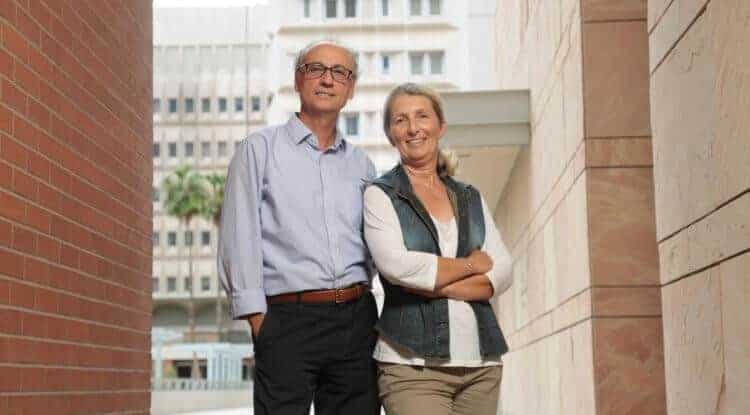Once you understand how something works, the next step is to figure out how to keep it working.
That is precisely the goal of Donato Romagnolo and Ornella Selmin of the University of Arizona Cancer Center.
Knowing that the BRCA1 gene functions as a tumor suppressor, Romagnolo and Selmin are working on a way to keep the gene from being repressed through epigenetic changes caused by environmental factors.
Roughly 5 to 10 percent of breast cancer diagnoses are a direct result of an inherited mutation on the BRCA1/BRCA2 genes. But what is causing the other 90 percent?
The researchers have identified the aryl hydrocarbon receptor, or AhR, as a nuclear factor that represses BRCA1 expression when it encounters ubiquitous environmental pollutants, metabolites of certain dietary fats or prolonged exposure to ultraviolet rays as a common link in non-inherited breast cancer cases.
“We’re still not sure if AhR is the cause or the effect — whether it’s driving the lower BRCA1 expression, or if it’s simply a passenger in a larger, more complex series of events,” Romagnolo said. “But we do know AhR is involved and its activation is repressive of BRCA1 expression in breast epithelial cells.”
Romagnolo and Selmin are among the few researchers investigating this potential link. Research funded by the Department of Defense Breast Cancer Research Program, along with the Arizona Biomedical Research Commission and the Soy Health Research Program, is allowing Romagnolo and Selmin to explore dietary compounds found in soy as a possible factor that can keep the activated AhR receptor from inhibiting the BRCA1 tumor suppressor gene.
This has the potential for broad and far-reaching implications. Soy foods are consumed extensively in the U.S. According to the Soy Foods Association of North America, 31 percent of Americans incorporate soy into their weekly diet, a 7 percent increase from 2010. U.S. consumers are spending more on soy products; the retail soy foods industry generated a total of $4.5 billion in revenue in 2013, up nearly 25 percent from the 1990s.
Soy consumption may be associated with reduced risk of breast cancer incidence, recurrence and mortality. But concerns remain about the timing and dose of exposure.
Romagnolo and Selmin are expanding on their investigation of a potentially groundbreaking genetic marker that could lead to more targeted therapies for previously untreatable breast cancer cases. This investigation specifically addresses the question of breast cancer susceptibility in women who have no family history of breast cancer.
The ultimate goal of this study is to determine whether AhR and its target genes can serve as a diagnostic markers to develop preventive models and new targeted therapies for estrogen receptor negative (and possibly triple-negative) breast cancers, providing safer, more effective treatments for a disease that claims more than 40,000 lives each year.
Last year, Romagnolo and Selmin published a paper in the journal Molecular Carcinogenesis, suggesting that exposure to these external environmental and dietary factors during gestation may have an impact on subsequent breast cancer risk for the offspring, as well.
The Romagnolo-Selmin study will test in an animal model how timing of exposure during gestation and genetic background influence mammary cancer risk in the female offspring. This may afford new insight into the transgenerational effects of soy intake on breast cancer risk and the refining of dietary recommendations for breast cancer prevention.
The BRCA1/BRCA2 mutation links to breast cancer made headlines worldwide when actress Angelina Jolie wrote about her experiences with her inherited genetic condition in 2013. Yet one thing nearly all breast cancer cases have in common is reduced expression in these genes, even if there is no inherited mutation or familial history with breast cancer.
The support comes from the Department of Defense’s $34 million breast cancer funding mechanism called “Breakthrough Award – Funding Level 2.” Romagnolo and Selmin are the principal investigators on one of the 16 programs out of 227 applications submitted through this funding mechanism.
Romagnolo and Selmin hold faculty appointments in the Department of Nutritional Sciences in the College and Agriculture of Life Sciences and share a laboratory at the Cancer Center. They have a long history of funding.
Each arrived at the Cancer Center in 1997 and began researching the links between AhR and breast cancer with their first successfully funded grant in 1999 through the Department of Defense. The DOD established the Breast Cancer Research Program in 1992 to promote innovative research focused on eradicating breast cancer.
In 2014, their research received the highly sought-after idea Expansion Award — a three-year, $560,000 grant to assist Romagnolo’s lab with setting up protocols and genetic models for the next phase of this study. Recently, the DOD included these findings as one of the BRCA1 research milestones.
“We know the BRCA1 gene’s blueprint, and we know some of the risk factors. The next step is to turn these findings into life-saving therapies,” Romagnolo said.


